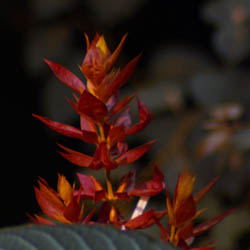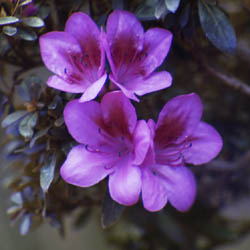Ultraviolet Bird Photography by Nathan Chronister
The Birds' Environment
One part of studying the ultraviolet vision in birds is to find out how they might be using this special ability. The feather coloration in many bird species doesn't seem to have an important UV component. Therefore it seems likely that the birds are using their ultraviolet vision for other purposes too. It's been suggested that UV vision might play a role in navigation or finding food.
I will start out with some botanical photography. Even though these are not necessarily plants that a bird would eat, it's a well-known fact that many flowers have special markings in ultraviolet. Insects can see ultraviolet light, and these markings are thought to play a role in helping insects to locate and identify the flowers that they visit for nectar.
Hummingbirds are among the birds that can see ultraviolet light, so perhaps the UV flower coloration may be important to them as well. Hummingbirds are often said to prefer red flowers. I photographed two different types of red flowers, to demonstrate how they can differ in their ultraviolet reflectance. The first example is a bright red flower that looks completely black in ultraviolet. In the combined UV and visible light photo, it retains most of its red color.
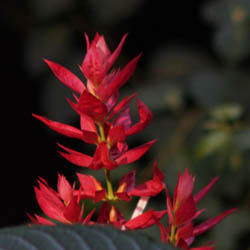 visible light photo |
 ultraviolet photo |
|
The next example is quite different. This is a type of azalea, which is very bright in the ultraviolet. But the center of the flower remains dark. A similar pattern is seen in other taxa, such as the composites, which are not closely related to this azalea. In the combined photo, the flower has a purple color, just as we saw in certain birds that reflect both red and UV light. It's important to understand though, birds would not see this as a purple flower. It's just a way for us, with our more limited color perception, to try to visualize the ultraviolet in some way. What it clearly shows is that even though these two flowers both look red to us, they will be seen as two completely different colors if you are a bird.
 visible light photo |
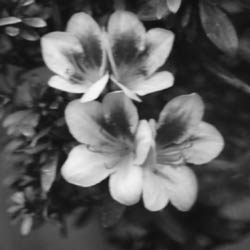 ultraviolet photo |
|
 |
In this photo of black-eyed susans, ultraviolet light is shown by the pattern of dots. In this way, you can perceive the original colors of the flower, as well as the ultraviolet reflectance, at the same time. This might be the closest we can come to experiencing the four-dimensional color perception that birds have. The black-eyed susan exhibits the common pattern of brightly reflective outer petals, with a UV-dark center. In this picture, the pattern is revealed through the lack of dots around the center of the flower. |
 |
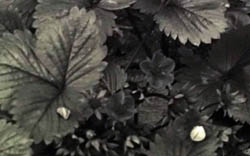 |
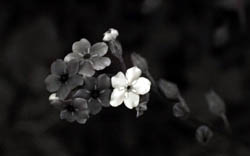 |
| Here are some pure ultraviolet photos of interesting plant specimens. The buttercup appears shiny and black in ultraviolet. | Can you find the strawberry blossoms in this photo? They aren't easy to see, because they too appear black in the ultraviolet photo. However, the fallen petals appear white! | I can never remember what this one is called. It has a cluster of pale blue flowers, which all look about the same color to the human eye. But in ultraviolet, each flower is different. Perhaps this UV coloration indicates which flowers are ready for pollination. |
Ultraviolet Photo Galleries
